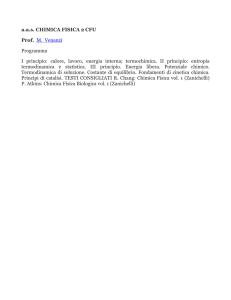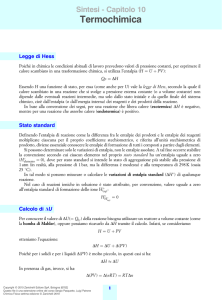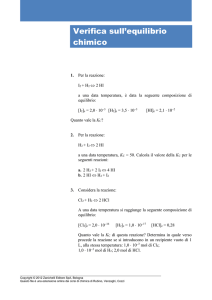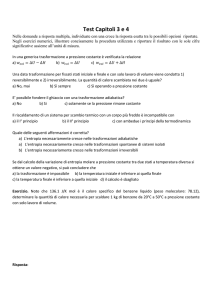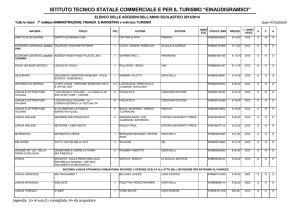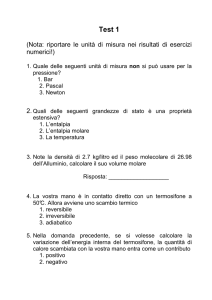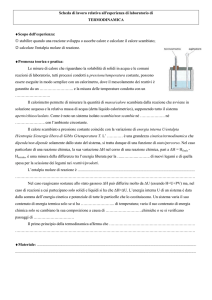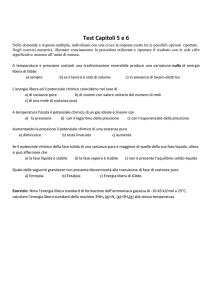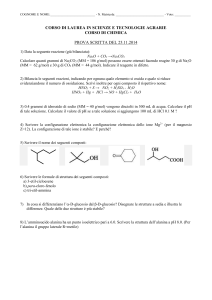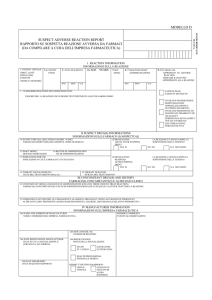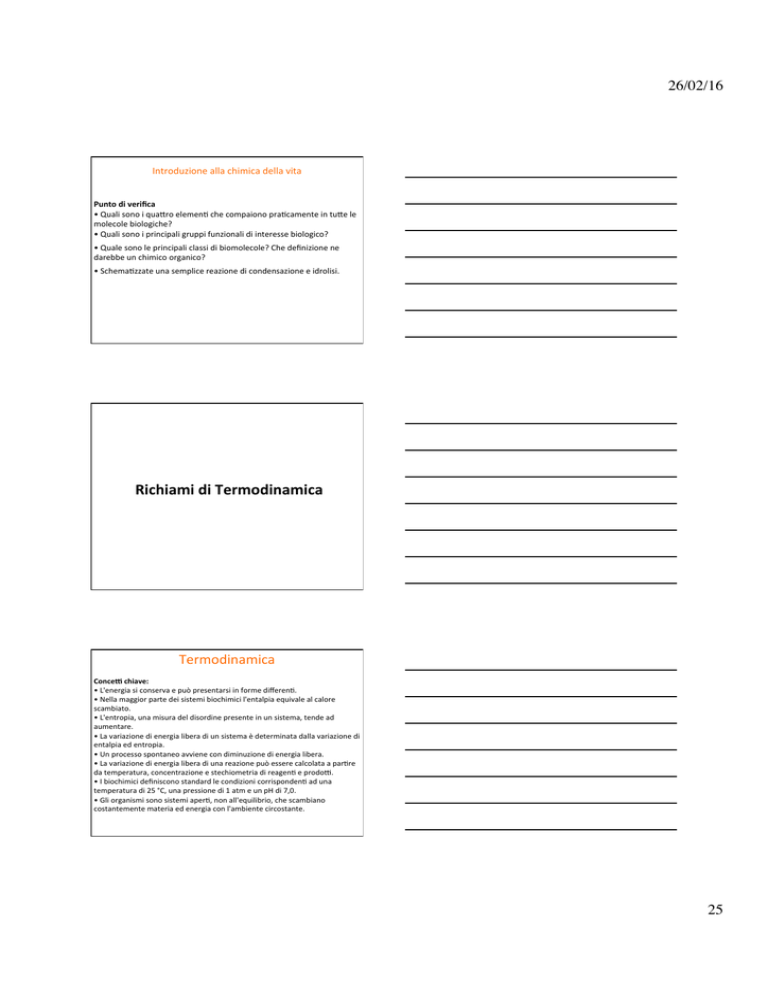
26/02/16
Introduzione alla chimica della vita Punto di verifica • Quali sono i quaFro elemenS che compaiono praScamente in tuFe le molecole biologiche? • Quali sono i principali gruppi funzionali di interesse biologico? • Quale sono le principali classi di biomolecole? Che definizione ne darebbe un chimico organico? • SchemaSzzate una semplice reazione di condensazione e idrolisi. Richiami di Termodinamica Termodinamica Conce@ chiave: • L'energia si conserva e può presentarsi in forme differenS. • Nella maggior parte dei sistemi biochimici l'entalpia equivale al calore scambiato. • L'entropia, una misura del disordine presente in un sistema, tende ad aumentare. • La variazione di energia libera di un sistema è determinata dalla variazione di entalpia ed entropia. • Un processo spontaneo avviene con diminuzione di energia libera. • La variazione di energia libera di una reazione può essere calcolata a parSre da temperatura, concentrazione e stechiometria di reagenS e prodoR. • I biochimici definiscono standard le condizioni corrispondenS ad una temperatura di 25 °C, una pressione di 1 atm e un pH di 7,0. • Gli organismi sono sistemi aperS, non all'equilibrio, che scambiano costantemente materia ed energia con l'ambiente circostante. 25
26/02/16
La biosfera: flusso di energia in un sistema aperto Termodinamica La termodinamica è la scienza che studia le proprietà e le trasformazioni dell’energia. La termochimica è un ramo della termodinamica che si occupa degli scambi di calore durante una trasformazione chimica. ValituR,Tifi, GenSle, Esploriamo la chimica © Zanichelli editore 2010 77
Energia: una definizione praSca L'energia misura l'aRdudine di un sistema a compiere lavoro. L’unità di misura dell’energia è il joule (J). Un’unità alternaSva, non SI, è la caloria, cal: 1 cal = 4,184 joule. Il lavoro necessario per muovere un oggeFo di una certa distanza contro una forza resistente si calcola molSplicando la forza per lo spostamento: w = forza x spostamento (1 J = 1 kg m2 s-­‐2) 26
26/02/16
Termodinamica Con il termine sistema s’intende l’oggeFo di studio. TuFo ciò che circonda il sistema cosStuisce l’ambiente In termodinamica: sistema + ambiente = universo ValituR,Tifi, GenSle, Esploriamo la chimica © Zanichelli editore 2010 79
Lavoro e calore: definizioni • Lavoro: è una forma di trasferimento dell'energia a un sistema mediante un processo che equivalga a sollevare o ad abbassare un peso. • Calore: è una forma di trasferimento dell'energia a un sistema mediante una differenza di temperatura tra sistema e ambiente. ValituR,Tifi, GenSle, Esploriamo la chimica © Zanichelli editore 2010 80
Lavoro e calore: interpretazione molecolare A livello microscopio, • il lavoro è un trasferimento d i energia che sSmola gli atomi a muoversi in modo coordinato, lungo una determinata direzione. • il calore è un trasferimento di energia che sSmola gli atomi circostanS a muoversi in modo disordinato, in tuFe le direzioni. ValituR,Tifi, GenSle, Esploriamo la chimica © Zanichelli editore 2010 81
27
26/02/16
Il primo principio della termodinamica Il primo principio della termodinamica afferma che l’energia può essere converSta da una forma all’altra, ma non può essere né creata né distruFa. L'energia che l'universo conSene oggi è uguale a quella che conterrà domani e a quella che ha contenuto nel passato. In effeR, anche se può assumere diverse forme e può passare da un sistema ad un altro, modificando così la sua densità e la sua distribuzione locale, l'energia nel suo complesso si conserva sempre. Primo vincolo imposto dalla natura alle trasformazioni: Possono verificarsi soltanto quei cambiamenS che lasciano inalterata l'energia totale dell'universo. ValituR,Tifi, GenSle, Esploriamo la chimica © Zanichelli editore 2010 82
Il primo principio della termodinamica e l’energia interna L’energia interna (U) di un sistema è una grandezza estensiva che corrisponde alla s omma dell’energia cineSca e dell’energia potenziale di tuFe le parScelle che lo compongono. L’energia interna, U, misura la capacità di un sistema di compiere lavoro. ValituR,Tifi, GenSle, Esploriamo la chimica © Zanichelli editore 2010 83
ENERGIA INTERNA In base al primo principio della termodinamica, la variazione di energia interna ΔU di un sistema può essere scriFa come: ΔU = q + w ValituR,Tifi, GenSle, Esploriamo la chimica © Zanichelli editore 2010 84
28
26/02/16
Il primo principio della termodinamica Per convenzione, lavoro e calore sono negaSvi se determinano una riduzione dell’energia interna del sistema. Sono posiSvi se aumentano l’energia interna del sistema. ValituR,Tifi, GenSle, Esploriamo la chimica © Zanichelli editore 2010 85
Reazioni esotermiche e reazioni endotermiche Le reazioni che avvengono con produzione di calore, cioè che trasferiscono energia termica dal sistema all’ambiente, si dicono esotermiche. Le reazioni che avvengono con assorbimento di calore dall’ambiente si dicono endotermiche. ValituR,Tifi, GenSle, Esploriamo la chimica © Zanichelli editore 2010 86
Reazioni esotermiche e reazioni endotermiche ValituR,Tifi, GenSle, Esploriamo la chimica © Zanichelli editore 2010 87
29
26/02/16
Le reazioni di combusSone sono sempre esotermiche La combusCone è una reazione fra un combusSbile (spesso contenente carbonio e/o idrogeno) e un comburente (contenente atomi ad alta eleFronegaSvità) in cui si libera un’elevata quanStà di energia. ValituR,Tifi, GenSle, Esploriamo la chimica © Zanichelli editore 2010 88
La combusSone in biochimica Il metabolismo energeCco è la serie di reazioni consecuSve aFraverso le quali avviene la lenta combusCone degli alimenS nell’organismo. Negli organismi vivenS l’energia liberata dalla combusSone degli alimenS viene in parte rilasciata soFo forma di calore e in parte trasformata in energia chimica uSle per le aRvità necessarie alla vita. ValituR,Tifi, GenSle, Esploriamo la chimica © Zanichelli editore 2010 89
ENTALPIA La funzione di stato entalpia è definita come: H = U + pV Nei sistemi biologici: P = cost e ΔV≅0 (PΔV≅0) da cui: H ≅ U ValituR,Tifi, GenSle, Esploriamo la chimica © Zanichelli editore 2010 90
30
26/02/16
ENTALPIA In un sistema chimico, la variazione di entalpia ΔH è uguale al calore qp scambiato a pressione costante. – HreagenS qp = ΔH = HprodoR
L'entalpia è il “contenuto termico” di un sistema e rifleFe il numero e il Spo di legami chimici delle sue molecole. ValituR,Tifi, GenSle, Esploriamo la chimica © Zanichelli editore 2010 91
ENTALPIA Considerando un sistema di reazione chiuso a pressione costante: ΔH < 0, i prodoR hanno meno entalpia dei reagenS: la reazione è esotermica: durante il suo svolgimento, riversa il “surplus” di energia verso l’esterno soFo forma di calore. ΔH > 0, i prodoR hanno più entalpia dei reagenS: la reazione è endotermica: durante il suo svolgimento, assorbe la differenza di energia soFo forma di calore dall’esterno. ValituR,Tifi, GenSle, Esploriamo la chimica © Zanichelli editore 2010 92
Entalpia standard di reazione L’entalpia di reazione dipende dalla temperatura e dalla pressione, oltre che dalla quanStà delle sostanze presenS nel sistema di reazione. Allo scopo di paragonare le variazioni di entalpia di reazioni diverse, è necessario esprimere i valori di ΔH riferendoli a uno stato standard. Secondo una convenzione standard quando la temperatura è di chimico-­‐fisica, un soluto si trova nel suo stato 25 °C (298.15 K), la pressione è di 1 atm (≅100 kPa) e quando la sua concentrazione è pari a 1 M. L’entalpia standard di reazione è la variazione di entalpia che accompagna la formazione dei prodoR in reagenS, ciascuno nel proprio stato standard. ΔH° = H°prodoR – H°reagenS ValituR,Tifi, GenSle, Esploriamo la chimica © Zanichelli editore 2010 93
31
26/02/16
Che cosa è spontaneo? Il secondo principio della termodinamica Se è vero che l'energia totale dell'universo non può mai cambiare, tuFavia il suo grado di "disordine", di “degrado”, o di "dispersione" è invece desSnato ad aumentare ogni volta che succede qualcosa. Qualunque trasformazione spontanea è accompagnata da un aumento dell’ENTROPIA dell’universo (enunciato di Clausius). ValituR,Tifi, GenSle, Esploriamo la chimica © Zanichelli editore 2010 95
Il secondo principio della termodinamica In generale, una qualsiasi trasformazione chimica o fisica spontanea è caraFerizzata da: ΔSuniverso = ΔSsist + ΔSamb > 0 La quanStà di disordine, o S, nell’universo aumenta sempre, qualunque cosa accada. Secondo vincolo imposto dalla natura alle trasformazioni: Possono verificarsi spontaneamente soltanto quei cambiamenS che aumentano il grado di dispersione dell’energia dell'universo. ValituR,Tifi, GenSle, Esploriamo la chimica © Zanichelli editore 2010 96
32
26/02/16
L’ENTROPIA: l’indicatore del «disordine» di un sistema L’entropia (S) misura il livello di dispersione dell’energia di un sistema, cioè il suo grado di disordine. Il disordine di un sistema può essere definito come il numero di modi equivalenS (W) di disporre i suoi componenS, ed è misurato dalla funzione di stato S secondo l’equazione: S = kB ln W (equazione di Boltzmann) dove kB è la costante di Boltzmann che vale kB = 1.381x10-­‐23 J/K ValituR,Tifi, GenSle, Esploriamo la chimica © Zanichelli editore 2010 97
L’entropia: definizione termodinamica In un sistema chimico a T costante, la variazione di entropia ΔS è uguale al calore q scambiato diviso per la T a cui avviene il trasferimento: ΔS = Sprodo@ – SreagenC ≥ q/T (definizione di Clausius) L'entropia di un corpo aumenta o diminuisce, a seconda che questo acquisS o perda energia soFo forma di calore. L'enStà di tale variazione è direFamente proporzionale all'energia trasferita mediante calore e inversamente proporzionale alla temperatura a cui avviene tale trasferimento. L’entropia è una funzione di stato estensiva e si misura in J/K. ValituR,Tifi, GenSle, Esploriamo la chimica © Zanichelli editore 2010 98
Entropia standard di reazione L’entropia standard di reazione è la variazione di entropia che accompagna la formazione dei prodoR in reagenS, ciascuno nel proprio stato standard. ΔS° = S°prodoR – S°reagenS ValituR,Tifi, GenSle, Esploriamo la chimica © Zanichelli editore 2010 99
33
26/02/16
Primo e secondo principio • ΔUuniverso ≅ ΔHsist + ΔHamb = 0 (1° principio) L’energia non può essere creata né distruFa. • ΔSuniverso = ΔSsist + ΔSamb > 0 (2° principio) Il grado di “disordine” dell’energia tende ad aumentare. ValituR,Tifi, GenSle, Esploriamo la chimica © Zanichelli editore 2010 100
ENERGIA LIBERA L’energia libera G è una grandezza termodinamica che dipende dall’entalpia, dalla temperatura assoluta e dall’entropia del sistema: G = H – TS G è una misura dell’energia immagazzinata in modo ordinato e quindi libera di compiere lavoro. ValituR,Tifi, GenSle, Esploriamo la chimica © Zanichelli editore 2010 101
Variazione di energia libera Durante una reazione a temperatura e pressione costanS si ha una variazione dell’energia libera espressa dalla relazione: ΔGsist = ΔHsist – TΔSsist ΔSsist è la misura della variazione del grado di disordine del sistema ΔHsist è la misura della variazione del contenuto energeSco del sistema ΔGsist è la misura della spontaneità della trasformazione del sistema ValituR,Tifi, GenSle, Esploriamo la chimica © Zanichelli editore 2010 102
34
26/02/16
L’energia libera unisce il primo e il secondo principio Una reazione procederà spontaneamente nel verso in cui l’energia libera diminuisce, perché in tal caso essa si accompagna ad un aumento dell’S dell’universo Quando il sistema ha raggiunto il suo minimo di G, ΔGsist= 0, coincidente con il massimo valore di S dell’universo per quelle condizioni, la reazione non tenderà a procedere oltre e avrà raggiunto l’equilibrio termodinamico ValituR,Tifi, GenSle, Esploriamo la chimica © Zanichelli editore 2010 103
La spontaneità di un processo dipende dall'entalpia e dall'entropia JWCL460_c01_001-021.qxd
5/11/11
7:05 PM
Page 15
Esempi di calcoli 15
Section 3 Thermodynamics
SAMPLE CALCULATION 1-1
The enthalpy and entropy of the initial and final states of a reacting system are
shown in the table.
H ( J ! mol"1)
S ( J ! K"1 ! mol"1)
Initial state (before reaction)
54,000
22
Final state (after reaction)
60,000
43
a. Calculate the change in enthalpy and change in entropy for the reaction.
b. Calculate the change in free energy for the reaction when the temperature is 4°C.
Is the reaction spontaneous?
c. Is the reaction spontaneous at 37°C?
a. !H " Hfinal # Hinitial " 60,000 J ! mol#1 # 54,000 J ! mol#1 " 6000 J ! mol#1
!S " Sfinal # Sinitial " !S " 43 J ! K#1 ! mol#1 # 22 J ! K#1 ! mol#1
" 21 J ! K#1 ! mol#1
b. First, convert temperature from °C to K: 4 $ 273 " 277 K. Then use Eq. 1-11.
!G " !H # T!S
!G " (6000 J ! mol#1) # (277 K)(21 J ! K#1 ! mol#1)
" 6000 J ! mol#1 # 5817 J ! mol#1 " 183 J ! mol#1
The value for !G is greater than zero, so this is an endergonic (nonspontaneous)
reaction at 4°C.
c. Convert temperature from °C to K: 37 $ 273 " 310 K.
!G " !H # T!S
!G " (6000 J ! mol#1) # (310 K)(21 J ! K#1 ! mol#1 )
" 6000 J ! mol#1 # 6510 J ! mol#1 " #510 J ! mol#1
The value for !G is less than zero, so the reaction is spontaneous (exergonic)
at 37°C.
of the system and ignoring all the stepwise changes in enthalpy and entropy that occur in between. For example, it is impossible to directly measure the energy change
for the reaction of glucose with O2 in a living organism because of the numerous other simultaneously occurring chemical reactions. But since !G depends on
only the initial and final states, the combustion of glucose can be analyzed in
any convenient apparatus, using the same starting materials (glucose and O2)
and end products (CO2 and H2O) that would be obtained in vivo.
D Free Energy Changes Can Be Calculated
from Equilibrium Concentrations
The entropy (disorder) of a substance increases with its volume. For example,
a collection of gas molecules, in occupying all of the volume available to it,
maximizes its entropy. Similarly, dissolved molecules become uniformly distributed throughout their solution volume. Entropy is therefore a function of
concentration.
If entropy varies with concentration, so must free energy. Thus, the free
energy change of a chemical reaction depends on the concentrations of both its
reacting substances (reactants) and its reaction products. This phenomenon has
great significance because many biochemical reactions operate spontaneously
in either direction depending on the relative concentrations of their reactants
and products.
35
26/02/16
Termodinamica Chimica STATO STANDARD BIOCHIMICO Energia libera standard di reazione L’energia libera standard di reazione è la variazione di G che accompagna la formazione dei prodoR in reagenS, ciascuno nel proprio stato standard ΔG° = G°prodoR – G°reagenS Energia libera standard di reazione secondo la convenzione biochimica ΔG°’ = G°’prodoR – G°’reagenS • [H+] = 10-­‐7 M, pH = 7 • [H2O] = 55.5 M Equilibrio Chimico 36
26/02/16
EQUILIBRIO CHIMICO 37
[1-14]
° $ aG A° $ bG B°
¢G° " cG C° % dG D
because free energies are additive and the free energy change of a reaction is
the sum of the free energies of the products less those of the reactants.
Substituting these relationships into Eq. 1-12 yields
_001-021.qxd
5/11/11
¢G " ¢G ° % RT ln a
3C4 c 3D4 d
3A4 a 3B4 b
b
[1-15]
where !G ° is the free energy change of the reaction when all of its reactants
and products are in their standard states (see below). Thus, the expression for
the free energy change of a reaction consists of two parts: (1) a constant term
whose value depends only on the reaction taking place and (2) a variable term
that depends on the concentrations of the reactants and the products, the stoichiometry
of the reaction, and the temperature.
Equilibrium Constants Are Related to !G. The relationship between
the
concentration and the free energy of a substance A is approximately
For a reaction at equilibrium, there is no net change because the free en[1-12]
GA " G °A % RT ln 3 A 4
ergy
change of the forward reaction exactly balances that of the reverse reacwhere GA is known as the partial molar free energy or the chemicaltion.
poten-Consequently, !G " 0, so Eq. 1-15 becomes
7:05 PM
Page 16
1 Introduction to the Chemistry of Life
tial of A (the bar indicates the quantity per mole), G°A is the partial molar
free energy
of A in its standard
state, R is the gas constant,
SAMPLE
CALCULATION
1-2and [A] is the
molar concentration of A. Thus, for the general reaction
% bB
∆ change
cC % dD
The standardaAfree
energy
for the rethe free energy
actionchange
A Sis B is $15 kJ " mol$1. What is
¢G " cGconstant
$ aG
bG B
C % dG D for
A $
the equilibrium
the
reaction?
and
tandard free energy change for the reA S B is $15 kJ " mol$1. What is
uilibrium constant for the reaction?
!G° is known, Eq. 1-17 can be used
culate Keq. Assume the temperature is
(298 K):
e$!G°/RT
# $1
# $1 # $1
e$1$15,000 J mol 2!18.314 J mol K 21298 K2
e6.05
426
Keq "
[1-13]
3C4 ceq 3D4 deq
3A4 aeq 3B4 beq
" e$¢G °!RT
[1-16]
[1-17]
[1-14]
° $ aG A° $ bG B°
¢G° " cG C° % dG D
Since !G°
is known, Eq.
1-17 can be used
The subscript “eq” denotes reactant and product concentrations at equilibbecause free energies are additive and the free energy change of a reaction is
to calculate Keq. Assume
the temperature is
rium. (The equilibrium condition is usually clear from the context of the sitthe sum of the free energies
of the products less those of the reactants.
25°C
K): into Eq. 1-12 yields
16
Substituting
these(298
relationships
uation, so equilibrium concentrations are usually expressed without this
JWCL460_c01_001-021.qxd
MPLE CALCULATION 1-2
¢G ° " $RT ln Keq
where Keq is the familiar equilibrium constant of the reaction:
26/02/16
5/11/11
7:05 PM
Chapter 1 Introduction to the Chemistry of Life
Page 16
Equilibrium Constants Are Related to !G. The relationship between the
substance
4 d A is approximately subscript.) The equilibrium constant of a reaction can therefore be calculated from
3 C of4 c a3 D
Keq " e$!G°/RTconcentration and the free energy
[1-12]
lnb3A4
[1-15]
¢G " ¢G
°%
RT ln Ga #" G °a$%1RT
b $1
$1
$1$15,000
J # Gmol
2!18.314
J 3mol
21298
K2chemicalstandard
Amolar
4 3 B#free
4K
where
is known
as the partial
energy
or the
potenfree energy data and vice versa (see Sample Calculation 1-2). The actual
"e
tial of A (the bar indicates the quantity per mole), G° is the partial molar
free energy
of A inofits the
standard
state, R iswhen
the gas constant,
is the energy change for a reaction can be calculated from the standard free
where !G ° is the 6.05
free energy
change
reaction
all of and
its [A]reactants
free
molar concentration of A. Thus, for the general reaction
"
e
and products are in their standard states (see
below). Thus, the expression for
aA % bB ∆ c C % d D
energy
the free energy"change
consists
of two parts: (1) a constant
term change (!G°#) and the actual concentrations of the reactants and prodfree energy change
is
426 of athereaction
A
A
A
A
ucts
(see Sample Calculation 1-3).
whose value depends only on the reaction
place
and (2) a variable
term
[1-13]
¢G taking
" cG C % dG
D $ aG A $ bG B
and
that depends on the concentrations
of the reactants and the products, the stoi[1-14]
° $ aG A° $ bG B°
¢G° " cG C° % dG D
chiometry of the reaction, and the temperature.
because free energies are additive and the free energy change of a reaction is
For a reaction at equilibrium,
is no ofnetthechange
because
thereactants.
free enthe sum of there
the free energies
products less
those of the
theseexactly
relationships
into Eq. 1-12
yieldsof the reverse reacergy change of the forwardSubstituting
reaction
balances
that
SAMPLE CALCULATION
3C4 c 3D4 d
tion. Consequently, !G " 0, so Eq. 1-15
[1-15]
¢G "becomes
¢G ° % RT ln a
a
b b
1-3
3A4 3B4
¢G
ln change
Keq of the reaction when all of its reactants
[1-16] the data provided in Sample Calculation 1-2, what is the actual free energy
where
!G°° "
is the$RT
free energy
Using
and products are in their standard states (see below). Thus, the expression for
the free energy change
of a reaction of
consists
two parts: (1) a constant change
term
where Keq is the familiar equilibrium
constant
theof reaction:
for the reaction A S B at 37°C when [A] " 10 mM and [B] " 0.1 mM?
whose value depends only on the reaction taking place and (2) a variable term
that dependsc on the concentrations
of the reactants and the products, the stoi3 C 4 3 D 4 deq and the
chiometry ofeqthe reaction,
temperature.
°!RT
" e$¢G
Keq "For a reaction
at bequilibrium,
there is no net change because the free[1-17]
enEquation
3 A 4 aeq
3 B forward
4 eq reaction exactly balances that of the reverse Use
ergy change
of the
reaction. Consequently, !G " 0, so Eq. 1-15 becomes
The
subscript
“eq” denotes
reactant and product
concentrations
at equilibSAMPLE
CALCULATION
1-2
¢G ° " $RT
ln Keq
[1-16]
where Keq is is
the usually
familiar equilibrium
constantthe
of thecontext
reaction: of the sitrium.
(The
equilibrium
clear from
The standard
free energy
change for the re- condition
¢G
"
c
d
action A S B so
is $15
kJ " mol . What is concentrations are 3C4
eq 3D4 eq expressed
uation,
equilibrium
usually
without
this
the equilibrium constant for the reaction?
[1-17]
" e$¢G °!RT
Keq "
3A4 aeq
3B4 beqtherefore be calculated from
subscript.) The equilibrium constant of a reaction
can
Since !G° is known, Eq. 1-17 can be used
The subscript “eq” denotes reactant and product concentrations at equilibstandard
energy
data isandrium.
vice(Theversa
(see condition
Sampleis usually
Calculation
1-2).
actual
to calculate K free
. Assume
the temperature
"
equilibrium
clear from the
contextThe
of the!G
sit25°C (298
K):
uation, so equilibrium
usually expressed
without thisfree
free
energy
change for a reaction
can beconcentrations
calculatedare from
the standard
K "e
subscript.) The equilibrium constant of a reaction can therefore be calculated from
#
#
#
energy
change
(!G°#)
and standard
the actual
concentrations
theCalculation
reactants
prod-"
free energy
data and vice versa (seeof
Sample
1-2). and
The actual
"e
free 1-3).
energy change for a reaction can be calculated from the standard free
ucts" e(see Sample Calculation
energy change (!G°#) and the actual concentrations of the reactants and prod"
$1
eq
eq
$!G°/RT
$1$15,000 J mol$12!18.314 J mol$1 K$121298 K2
6.05
" 426
ucts (see Sample Calculation 1-3).
SAMPLE 1-3
CALCULATION
SAMPLE CALCULATION
1-15.
¢G ° % RT ln
3B4
3A4
$15,000 J " mol$1 % (8.314 J " mol$1 " K$1)(37 % 273 K) ln(0.1!10)
$15,000 J " mol$1 $ 11,900 J " mol$1
$26,900 J " mol$1
1-3
Using the data provided in Sample Calculation 1-2, what is the actual free energy
change for the
reaction A S B 1-2,
at 37°Cwhat
when [A]is"the
10 mM
and [B] free
" 0.1 energy
mM?
Using the data provided in Sample
Calculation
actual
change for the reaction A S Use
B at
37°C
Equation
1-15.when [A] " 10 mM and [B] " 0.1 mM?
¢G " ¢G ° % RT ln
Use Equation 1-15.
¢G " ¢G ° % RT ln
3B4
3A4
3B4
3A4
!G " $15,000 J " mol$1 % (8.314 J " mol$1 " K$1)(37 % 273 K) ln(0.1!10)
" $15,000 J " mol$1 $ 11,900 J " mol$1
" $26,900 J " mol$1
!G " $15,000 J " mol$1 % (8.314 J " mol$1 " K$1)(37 % 273 K) ln(0.1!10)
" $15,000 J " mol$1 $ 11,900 J " mol$1
" $26,900 J " mol$1
La biosfera: flusso di energia in un sistema aperto 38
26/02/16
Stato Stazionario (steady state) Living Cells Maintain a Dynamic Steady State Fuels such as glucose enter a cell, and waste products such as CO2 leave, but the mass and the gross composiSon of a typical cell do not change appreciably over Sme; cells and organisms exist in a dynamic steady state, but not at equilibrium with their surroundings. At the molecular level, this means that for each metabolic reacSon in a pathway, the substrate is provided by the preceding reacSon at the same rate at which it is converted to product. Thus, although the rate of metabolite flow, or flux, through this step of the pathway may be high, the concentraSon of substrate, S, remains constant. For the reacSon v1 v2 R S T when v1 = v2, [S] is constant. When the steady state is disturbed by some change in external circumstances or energy supply, the temporarily altered fluxes through individual metabolic pathways trigger regulatory mechanisms intrinsic to each pathway. The net effect of all these adjustments is to return the organism to a new steady state—to achieve homeostasis. Stato stazionario e equilibrio chimico How do the mulSlayered regulatory mechanisms cooperate to balance metabolic and energy inputs and outputs, achieving the dynamic steady state of life? Studied with this perspecSve, metabolism provides fascinaSng and revealing insights into life, with countless applicaSons in medicine, agriculture, and biotechnology. Termodinamica Punto di verifica: • Riassumete la relazione tra energia (U), calore (q) e lavoro (w). Enunciate il primo e il secondo principio della termodinamica. • Spiegate perché le variazioni di entalpia (ΔH) e di entropia (ΔS) determinano la spontaneità di un processo. 39
26/02/16
Capitolo 1 Termodinamica Punto di verifica 1.3: di una reazione all'equilibrio? • Qual è la variazione di energia libera • Scrivete l'equazione che mostra la relazione tra ΔG° e Keq. • Scrivete l'equazione che mostra la relazione tra ΔG, ΔG° e le concentrazioni dei reagenS e dei prodoR. • Spiegate come i biochimici definiscono lo stato standard di un soluto. Perché i biochimici e i chimici usano convenzioni differenS? 12
JWCL460_c01_001-021.qxd
5/11/11
7:05 PM
Chapter 1 Introduction to the Chemistry of Life
Page 12
the surroundings and work (w) done by the system on the surroundings. The
Greek s
letter
! (Delta) indicates
• Spiegate che cos’è lo stato tazionario e cchange.
he differenza esiste con lo !U " U
#U
"q#w
[1-1]
stato di equilibrio Heat is a reflection of random molecular motion, whereas work, which is defined as force times the distance moved under its influence, is associated with
• Spiegate in che modo gli organized
organismi evitano di raggiungere l'equilibrio motion. Force may assume many different forms, including the gravitational force exerted by one mass on another, the expansional force exerted by
pur mantenendo uno stato stazionario. a gas,
the tensional force exerted by a spring or muscle fiber, the electrical force
final
initial
of one charge on another, and the dissipative forces of friction and viscosity.
Because energy can be used to perform different kinds of work, it is sometimes
useful to speak of energy taking different forms, such as mechanical energy, electrical energy, or chemical energy—all of which are relevant to biological systems.
Most biological processes take place at constant pressure. Under such conditions, the work done by the expansion of a gas (pressure–volume work) is
P!V. Consequently, it is useful to define a new thermodynamic quantity, the
enthalpy (Greek: enthalpein, to warm in), abbreviated H:
H " U $ PV
[1-2]
Then, when the system undergoes a change at constant pressure,
!H " !U $ P!V " qP # w $ P!V
[1-3]
where qP is defined as the heat at constant pressure. Since we already know
that in this system w " P!V,
!H " qP # P!V $ P!V " qP
[1-4]
In other words, the change in enthalpy is equivalent to heat. Moreover, the
volume changes in most biochemical reactions are insignificant (P!V ! 0),
so the differences between their !U and !H values are negligible, and hence
the energy change for the reacting system is equivalent to its enthalpy change.
Enthalpy, like energy, heat, and work, is given units of joules. (Some commonly used units and biochemical constants and other conventions are given
in Box 1-2.)
Tabella finale riassunCva Box 1-2 Perspectives
in Biochemistry
Biochemical Conventions
Modern biochemistry generally uses Système International (SI) units,
including meters (m), kilograms (kg), and seconds (s) and their
derived units, for various thermodynamic and other measurements.
The following lists the commonly used biochemical units, some
useful biochemical constants, and a few conversion factors.
Constants
Units
Faraday (f)
Energy, heat, work
Electric potential
joule (J)
volt (V)
kg ! m2 ! s#2 or C ! V
J ! C#1
Prefixes for units
mega (M)
kilo (k)
milli (m)
micro (%)
106
103
10#3
10#6
nano (n)
pico (p)
femto (f)
atto (a)
10#9
10#12
10#15
10#18
Conversions
angstrom (Å)
calorie (cal)
kelvin (K)
Avogadro’s number (N)
Coulomb (C)
Gas constant (R)
Boltzmann constant (kB)
Planck’s constant (h)
6.0221 & 1023
molecules ! mol#1
6.241 & 1018
electron charges
96,485 C ! mol#1 or
96,485 J ! V#1 ! mol#1
8.3145 J ! K#1 ! mol#1
1.3807 & 10#23 J ! K#1 (R/N)
6.6261 & 10#34 J ! s
Throughout this text, molecular masses of particles are expressed
in units of daltons (D), which are defined as l"12th the mass of
a 12C atom (1000 D " 1 kilodalton, kD). Biochemists also use
molecular weight, a dimensionless quantity defined as the ratio
of the particle mass to l"12th the mass of a
symbolized Mr (for relative molecular mass).
12
C atom, which is
10#10 m
4.184 J
degrees Celsius (°C) $ 273.15
Le proprietà fisiche dell'acqua Conce@ chiave • Le molecole d'acqua, che sono polari, possono formare legami idrogeno con altre molecole. • Nel ghiaccio le molecole d'acqua sono disposte a formare un reScolo cristallino ordinato tenuto insieme da legami idrogeno, mentre allo stato liquido i legami idrogeno si rompono e si riformano rapidamente originando un reScolo irregolare. • Le forze di aFrazione che agiscono sulle molecole biologiche comprendono le interazioni ioniche, i legami idrogeno e le interazioni di van der Waals. • Le sostanze polari e ioniche sono solubili in acqua. 40

